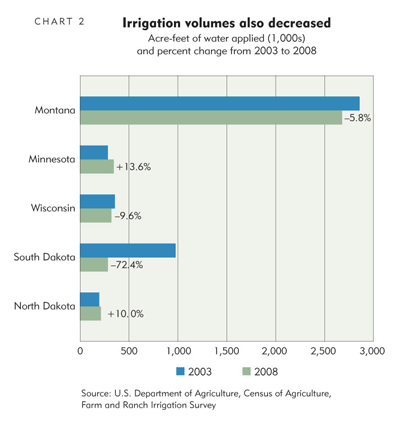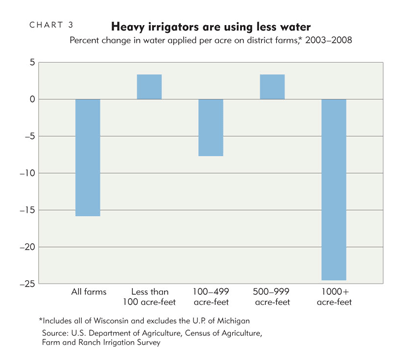
After years of letting irrigation water flow freely in their fields, Ninth District farmers have tightened the spigot. From 2003 to 2008, irrigation on farms and ranches decreased in district states, even as producers continued to reap bountiful harvests of corn, soybeans, wheat and other crops.
Much of the decline in both irrigated acreage and total water use occurred because of the return of rain after a dry spell, but an additional factor has helped to reduce water use: Operations that use the most water are using less on average than in the past.
Irrigation is crucial to agriculture in the dry, western reaches of the District—Montana and the Dakotas west of the Missouri River—but is also common in wetter eastern states, to boost crop yields when rainfall lags. In 2008, the U.S. Department of Agriculture (USDA) analyzed agricultural water usage, comprising on-farm sources such as wells and creeks as well as off-farm sources such as federally controlled rivers and reservoirs.
The Farm and Ranch Irrigation Survey found that, compared with 2003 figures, acres of irrigated farmland in Minnesota, Montana, the Dakotas and Wisconsin fell 3 percent. This decline reversed an upward trend in district irrigated acres from 1997 to 2003 and ran counter to the national trend, which saw irrigated acres dip in 2003 and then increase in the most recent survey (see Chart 1).
Total water usage dropped even more in the district; from 2003 to 2008, the volume of water applied (in acre-feet) in district states declined 18 percent. Nationally, water volume decreased 5 percent during the same period.
The most important driver of year-to-year fluctuations in irrigation is rainfall, or the lack of it. Peak levels of irrigation in 2003 coincided with a drought that was particularly severe in South Dakota and Montana. Subsequent easing of drought—2008 was relatively wet—reduced the need to irrigate, causing a drop in both irrigated acreage and water use. But there may be more to the decline in water use than the return of rain; district water usage in 2008 dipped about 1 percent below 1998 levels, despite robust growth in farm output in recent years. (From 2003 to 2008, district production of corn, soybeans and wheat increased 28 percent.)
Much of the district decline in water use occurred in South Dakota; operators in the state applied 72 percent less water in 2008 than five years earlier (see Chart 2). Irrigation volume also declined in Montana. Drought was less severe in the eastern part of the district, so water use in that region didn’t change much. In fact, it increased slightly in Minnesota and in North Dakota.
Because some crops demand more water than others, changes in the crops farmers plant can affect irrigation volume. But there’s no evidence that changes in crop mix have anything to do with the falloff in irrigation between 2003 and 2008. The number of irrigated acres dedicated to corn, a water-intensive crop, jumped dramatically in district states over that period—56 percent in North Dakota and almost threefold in Montana. But irrigated acres of soybeans, another thirsty crop, declined. It’s likely that the increase in rainfall after 2003 swamped any crop-related impact on water use.
More water, less waste
Beyond the impact of increased rainfall, another factor that has lowered water use in recent years is more effective irrigation by heavy users. Intensive irrigators—which also tend to be relatively large operations—can take advantage of economies of scale. Between 2003 and 2008, water applied per acre by the biggest irrigators fell, reducing their share of aggregate water use. In contrast, water use by farms applying less than 1,000 acre-feet was generally a wash (see Chart 3).
In Wisconsin, for example, water applied per acre fell more than 10 percent for all irrigators, but it fell more than twice as much on farms using more than 1,000 acre-feet of water. Meanwhile, water use per acre increased 15 percent among farms using between 100 and 499 acre-feet.
In North Dakota, although overall water use increased, the average volume of water applied per acre by operations using 1,000 acre-feet or more fell by almost a quarter, while it increased 19 percent for operations using less than 100 acre-feet.
How have intensive irrigators cut their water consumption? By investing in technologies that conserve water. The irrigation survey showed that many big farms are switching from gravity irrigation systems to new sprinkler systems that apply water more precisely and are less prone to leakage. From 2003 to 2008, the area of district farmland irrigated by gravity systems fell 18 percent, while the acreage watered by sprinklers increased almost 12 percent.
Upgrading irrigation systems can be expensive, and indeed the survey shows an increase in irrigation expenditures, particularly by large operations. The number of district farms spending more than $75,000 (the highest value the USDA tracks) on irrigation equipment more than doubled between surveys.
Continued investment in water-saving equipment by farms and ranches in the district may lead to further reductions in irrigation—until the next drought, at least.
Joe Mahon is a Minneapolis Fed regional outreach director. Joe’s primary responsibilities involve tracking several sectors of the Ninth District economy, including agriculture, manufacturing, energy, and mining.








